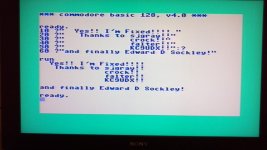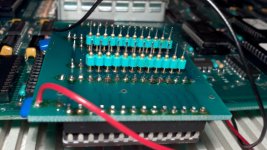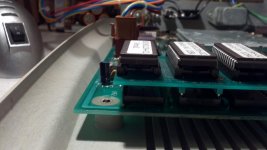Pet Rescue
Experienced Member
If I have an 8-bit that basically boots but hangs, I would be going down the faulty RAM route now. On the insectria site there was a nice suggestion about removing the BASIC ROM. This means the computer boots into the monitor. You can then start selectively filling memory with various bit patterns to try and determine the issue. It's possible that if it is memory, and it affects the zero or stack pages, that the monitor will probably hang as well. At that point I would resort to making a bespoke kernal that does some very basic RAM checks, thought I don't know whether is is possible for you.
Regarding replacing your 6525's - do not despair, they are much easier to find than 6509's as they were also used in 1551 disk drives and in Amiga CD-ROM drives. I see them maybe once every few months on ebay, though you might want to include worldwide in your search criteria.
+1 for what KC9UDX said. Just practise on junk boards. If you are not certain that the chip is dead or not easily replaceable, never cut the pins as most will survive a de-soldering. The odd broken trace or via (the holes in the pcb, which are usually plated through) can be easily spotted and fixed once the chip is removed. My technique is to use a Weller 35W iron with a chisel tip, which is not temperature controlled, and a pump action solder sucker. I heat each pin until the solder visually melts, plus about 1 second, then suck. After doing all 40 pins, flip the board and using quick applications of the iron, push the legs inwards along both sides of the chip and you usually feel a soft click as the leg frees itself from the outside wall of the via. Most new chips have the legs spread outwards so even after sucking, the legs will often still be attached to the outside with the small amount of residual solder. I then work along each pin checking it is free, using a small screwdriver. You can then usually insert a screwdriver under one end of the chip and it will come free with a gentle twist at both ends. A *small* amount of force is OK here but it should not need much. If it isn't coming free, recheck each pin and repeat as required.
You will very occasionally find an obstinate bugger that needs a bit more persuasion, this is when you can find that traces get lifted or a via gets pulled out on the leg of the chip. You should perform a careful visual check of the legs of the pin to see if any via's have been pulled out and the board to check for lifted, broken traces. I usually clean up the board with braid and then PCB cleaner after removing the chip and this makes it much easier to spot faults. If you have, just make a note of where the traces run and fix with fine cored wire on the back side of the board once the socket is fitted.
Hope this helps, Rob
Thanks for the pointers Rob I will take a look at the RAM next, thanks also for the extra info on removing the chips I'm definitely going to get practicing now and exorcise those demons!



